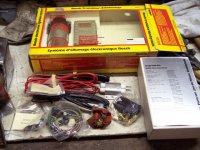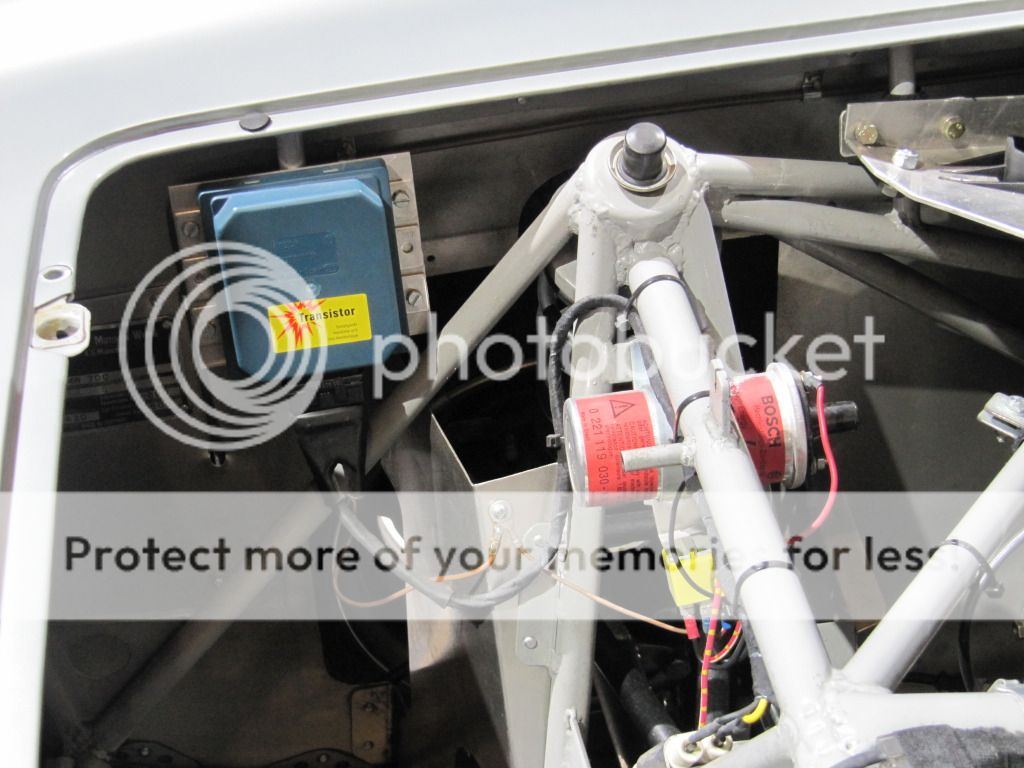terminal. The circuit is designed to relieve the breaker points of electric erosion caused by
heavy current, thereby rendering point adjustment unnecessary after the first 5000 mi. until over
50,000 mi., so that ignition performance does not degrade below its optimum as time passes. I
used this circuit for five years, 1969-73, in a car driven across the continent three times in all
weath
Tight grounds and clean points are crucial lest Q be destroyed. Under normal conditions the
circuit dissipates less than 3W.; still, Q and Zs should be clamped to a heat-sink in a waterproof
box mounted low in the engine compartment away from heat sources and vibration. Only
failure of switch Sw or capacitor C can disable both ignition modes. Install with fresh points!
Since point erosion is almost eliminated you may safely increase point dwell by up to 20% and
advance spark timing by 2° to retard rubbing-block wear and improve high-speed performance.
And widening spark-plug gaps by about 20% will improve low-speed running and starting.
• • • •
o FT]
[/B][/SIZE][/SIZE][/FONT]
This responds to repeated requests for explanations of the foregoing circuit. Because I last saw it
in late 1973, after which the circuit was supplanted by a stronger capacitive discharge ignition,
what follows has to be based upon an old man’s unreliable memory. My cars were 1969 Peugeot
404s with automatic transmissions. I do recall replacing their Ducellier ignition coil with a
Lucas SA12, salvaged from a junk yard, to increase the voltage at the spark plug.
The circuit’s ground connections are crucial; the cases of Q and C must be connected to the
motor’s head and block and, after them, to the battery’s negative pole with the lowest practical
resistance, less than 0
.05
W
. The shield’s braid connects the circuit’s ground to the fixed contact
of the tungsten breaker points in the distributor. The resistance across clean points, when closed,
should not exceed about 0.2
W
. The circuit puts enough current through them when closed, and
enough voltage across them when they open, to keep them clean unless motor oil leaks into the
distributor and sprays around inside it.
When the points are closed, the base B of Q comes down within millivolts of the grounded
collector c of Q. Current from the coil comes down through Q’s emitter E and builds up to as
much as 7A, going almost entirely through collector c to ground. A small fraction of the coil’s
current, depending upon Q’s current-gain at near-saturation, flows from E through base B and
then through the points to ground. As the coil’s current rises, so does E’s voltage above ground,
but it rises to less than a volt. This pushes at most a few tens of milliamps through inductance L.
When the points open, L’s current generates a voltage that reverse-biases base B to speed the
cut-off of collector current. Diodes D prevent that reverse-bias from exceeding what Q can
tolerate. Meanwhile capacitor C absorbs the coil’s current for long enough to allow Q to stop
conduction. Then the coil’s current builds a rapid rise of voltage across capacitor C, emitter E
and, through base B, across the now open points. Zener diodes Z prevent that rising voltage
from exceeding what Q can tolerate from E to c. When that voltage rises high enough, at least
200V, the coil’s transformer action puts out at least 10 KV to a spark-plug selected by the
distributor, just as would happen if switch Sw had been set to Standard Ignition. After the
spark, oscillating currents between C and the coil are damped down by diodes Z.
The advantage over then Standard ignition of this Transistorized ignition is only that the current
through the points is reduced well below what would erode them by sparks’ action. The points do
get beaten down by banging against each other, and the breaker arm’s fiber rubbing block gets
worn down by friction with the cam in the distributor, but these effects slow down and become
negligible after about 5000 miles provided the cam is greased adequately but not excessively.
The points get work-hardened by beating against each other; the fiber block becomes smoothed
and slippery, saturated with grease. After 5000 miles I did adjust the ignition for longer dwell
and advanced spark timimg; these remained practically unchanged for the next 75000 miles
until, with the change to Capacitive Discharge ignition, I advanced spark timing a little more.
That stayed put for the next 40000 miles, after which the cars were retired because I could not
get exact replacements for the brakes’ master cylinders. Otherwise I would still be driving them.






































